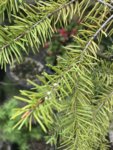You are using an out of date browser. It may not display this or other websites correctly.
You should upgrade or use an alternative browser.
You should upgrade or use an alternative browser.
What’s On This Collected Doug Fir?
- Thread starter Josh88
- Start date
wireme
Masterpiece
Coolley spruce gall adelgid.
I might have spelt it wrong but that’s them.
I might have spelt it wrong but that’s them.
wireme
Masterpiece
They will feed on the young needles when the buds open discolouring them very quickly.
They can be blasted off with water but it takes persistence and you need to develop the technique, it’s not easy. Dusting with DE when they are very young and haven’t grown the white fluff yet works ok. Small window of time there just as buds are elongating. Insecticidal soap during this stage also works very well but the soap may strip the protective covering off young emerging needles leaving them more susceptible to a needle rust that’s very common with dougies. I’m not really sure that’s the case but have thought I noticed a co-relation before, maybe it was just weather.
They can be blasted off with water but it takes persistence and you need to develop the technique, it’s not easy. Dusting with DE when they are very young and haven’t grown the white fluff yet works ok. Small window of time there just as buds are elongating. Insecticidal soap during this stage also works very well but the soap may strip the protective covering off young emerging needles leaving them more susceptible to a needle rust that’s very common with dougies. I’m not really sure that’s the case but have thought I noticed a co-relation before, maybe it was just weather.
Tbwilson33
Mame
You rightCoolley spruce gall adelgid.
I might have spelt it wrong but that’s them.
Josh88
Shohin
Thank you!They will feed on the young needles when the buds open discolouring them very quickly.
They can be blasted off with water but it takes persistence and you need to develop the technique, it’s not easy. Dusting with DE when they are very young and haven’t grown the white fluff yet works ok. Small window of time there just as buds are elongating. Insecticidal soap during this stage also works very well but the soap may strip the protective covering off young emerging needles leaving them more susceptible to a needle rust that’s very common with dougies. I’m not really sure that’s the case but have thought I noticed a co-relation before, maybe it was just weather.
Potawatomi13
Imperial Masterpiece
Had these on a Ponderosa past year. Much agreement to using insecticidal soap .
.
PiñonJ
Omono
When they’re done with your dougie, they’ll move on to your spruces, where the galls will form, to produce the next generation.
Josh88
Shohin
How far away from other trees should I keep this to avoid cross contamination?When they’re done with your dougie, they’ll move on to your spruces, where the galls will form, to produce the next generation.
Tough to prevent 100%. I’d keep it downwind of your other trees so prevailing winds don’t blow loose ones into new foliage. Perching birds can get them on their feet and transport them. I think Wireme’s suggestions are good. Knock em down while you can and be vigilant.
PiñonJ
Omono
PiñonJ
Omono
Your best bet is to kill them as soon as you identify them on the dougie.
wireme
Masterpiece
Part of their lifecycle is migratory with wings so...distance may not matter much.
Depends, if this is the only tree around with the critters then, downwind as arctic says, get’em right away before they multiply as per piñon and no more problems. It would be nice to live somewhere they are not everywhere. Here the forest is full of them so they will always be a thing no matter what I do. Maybe someday I’ll break down and try the systematic route... Actuality, I watch the trees in the forest with incredibly heavy infestations and it surprising how well they continue to grow
Wireme brings up a point. If you have large natural dougies or spruce in your yard, you don’t want an infestation started in them. It’s much harder to control a bug problem in a 80’ tree. Your trees in your collection could be reinfested every year. I’d shade my newly collected stock under some big spruce in my yard in central OR. I kept finding scale on my collected stuff. Took a while to figure out the big shading spruce were infested with them and passing it on to all my collected material underneath.
parhamr
Omono
I had trouble with these pests this year, too. They spread to 3 or so trees that were all about 30 feet apart. I manually killed most of them and ensured all stragglers were finished off by malathion.
wireme
Masterpiece
I had trouble with these pests this year, too. They spread to 3 or so trees that were all about 30 feet apart. I manually killed most of them and ensured all stragglers were finished off by malathion.
Did you find them on any of your spruce?
parhamr
Omono
Yes. My Engelmann and Black Hills spruce were both attacked.Did you find them on any of your spruce?
I don’t remember them having any luck with my subalpine fir.
Similar threads
- Replies
- 2
- Views
- 230


